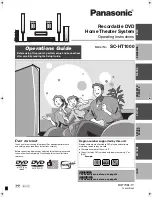
External Factors
1.
Display device signal processing values
Due to differences in digital signal handling, display devices vary in their ability to reproduce a usable picture.
Digital projectors tend to display every flaw in a video signal. The same video signal that looks wonderful on
your office CRT monitor may be terrible on a digital projector. High-end projectors show the signal with much
greater accuracy than most monitors do.
However, even the digital circuitry in a brand name projector is not always above suspicion. The digital signal
path through the projector can degrade the image, and the change in quality may range from unnoticeable to
unusable. This varies not only from one brand to another, but also from one product line to another in the same
brand (sometimes engineering teams work as discrete entities when designing product).
If you are having unexpected picture quality issues, first verify that you are viewing the material in the same
manner (i.e., on the same make and model) that you previously used. If it is different, expect some quality
differences. After that, the best solution is to check the settings for the display devices, and check the other
inputs to see if a better quality picture can be obtained by running a signal into it via a different input (i.e., using
HD via RGB rather than SDI).
2.
Cable quality and cable length
The quality of your cable makes a big difference. Cables of the same length but from different manufactures
will exhibit different performance characteristics. Where possible, QuVIS recommends you use Belden 1694A
“Brilliance” cable for serial video applications.
Remember that even quality cabling is subject to principles of physics (attenuation of the carrier signal due to
distance, connections, and patching equipment). For all cables, long cable runs will weaken high-frequency
signals, and unshielded electrical sources (like power cables placed alongside video cable) can definitely
interfere with the signal.
Video output signals can travel anywhere from 25 feet (7.6m) to 335 (102m) depending on the quality rating of
the cable used. If you need a longer run than your cable supports, you will need to use the proper distribution
amplifier to boost/equalize the signal.
3.
Ambient light and screen framing
The amount of ambient light in a room has a direct bearing on the depth and clarity of the images you see. This
is the reason movie theatres are nearly black inside. The more you can control the light levels in the room, the
better the image.
In addition, many projection screens are framed with a wide black frame. This enhances the appearance of
brightness and clarity to the eye.
QuVIS Acuity
™
Page 62
QSR Version 3.3
Содержание Acuity
Страница 1: ......
Страница 152: ...Keyboard Hotkeys Description ENTER Complete current edit QuVIS Acuity Page 151 QSR Version 3 3...
Страница 190: ...QuVIS Acuity Page 189 QSR Version 3 1...
Страница 200: ......
















































